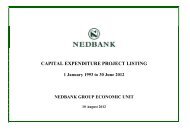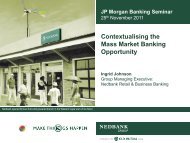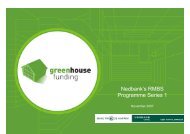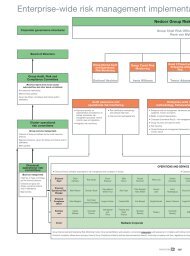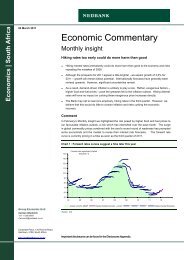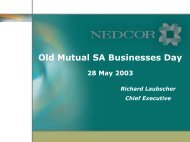NEDBANK CAPITAl - Nedbank Group Limited
NEDBANK CAPITAl - Nedbank Group Limited
NEDBANK CAPITAl - Nedbank Group Limited
- No tags were found...
Create successful ePaper yourself
Turn your PDF publications into a flip-book with our unique Google optimized e-Paper software.
isk and BALANCE SHEET management reportTrading market riskTrading market risk is the potential for changes in the marketvalue of the trading book resulting from changes in the marketrisk factors over a defined period. The trading book is defined aspositions in financial instruments and commodities, includingderivative products and other off-balance-sheet instrumentsthat are held with trading intent or used to hedge otherelements of the trading book.Categories of trading market risk include exposure to interestrates, equity prices, currency rates and credit spreads.A description of each market risk factor category is set outbelow:• Interest rate risk primarily results from exposure to changesin the level, slope and curvature of the yield curve and thevolatility of interest rates.• Equity price risk results from exposure to changes in pricesand volatilities of individual equities and equity indices.• Currency rate risk results from exposure to changes in spotprices, forward prices and volatilities of currency rates.• Credit spread risk results from exposure to changes in therate that reflects the spread investors receive for bearingcredit risk.• Commodity price risk results from exposures to changes inspot prices, forward prices and volatilities of commodityproducts such as energy, agricultural products and preciousand base metals.Most of <strong>Nedbank</strong> <strong>Group</strong>’s trading activity is executed from<strong>Nedbank</strong> Capital. During 2009 it included market-making andfacilitation of client business and proprietary trading in thecommodity, equity, credit, interest rate and currency markets.<strong>Nedbank</strong> Capital primarily focuses on client activities in thesemarkets.In addition to applying business judgement, seniormanagement uses a number of quantitative measures tomanage the exposure to market risk. These measures include:• risk limits based on a portfolio measure of market riskexposure referred to as value at risk (VaR), including expectedtail loss; and• scenario analyses, stress tests and other analytical toolsthat measure the potential effects on the trading revenue ofvarious market events.The material risks identified by these processes are summarisedin reports produced by the Market Risk Department and whichare circulated to, and discussed with, senior management.VaR is the potential loss in pretax profit due to adverse marketmovements over a defined holding period with a specifiedconfidence level. The one-day 99% VaR number used by<strong>Nedbank</strong> <strong>Group</strong> reflects at a 99% confidence level that thedaily loss will not exceed the reported VaR and therefore thatthe daily losses exceeding the VaR figure are likely to occur, onaverage, once in every 100 business days. The VaR methodologyis a statistically defined, probability-based approach that takesinto account market volatilities as well as risk diversificationby recognising offsetting positions and correlations betweenproducts and markets. VaR facilitates the consistentmeasurement of risk across all markets and products, and riskmeasures can be aggregated to arrive at a single risk number.<strong>Nedbank</strong> <strong>Group</strong> uses historical data to estimate VaR. Oneyear of historical data is used in the calculation. Some ofthe considerations that should be taken into account whenreviewing the VaR numbers are the following:• The assumed one-day holding period will not fully capturethe market risk of positions that cannot be liquidated oroffset with hedges within one day.• The historical VaR assumes that the past is a goodrepresentation of the future, which may not always be thecase.• The 99% confidence level does not indicate the potentialloss beyond this interval.While VaR captures <strong>Nedbank</strong> <strong>Group</strong>’s exposure under normalmarket conditions, sensitivity and stress-and-scenario analyses(and in particular stress testing) are used to add insight intothe possible outcomes under abnormal market conditions.160<strong>NEDBANK</strong> GROUP ANNUAL REPORT 2009



